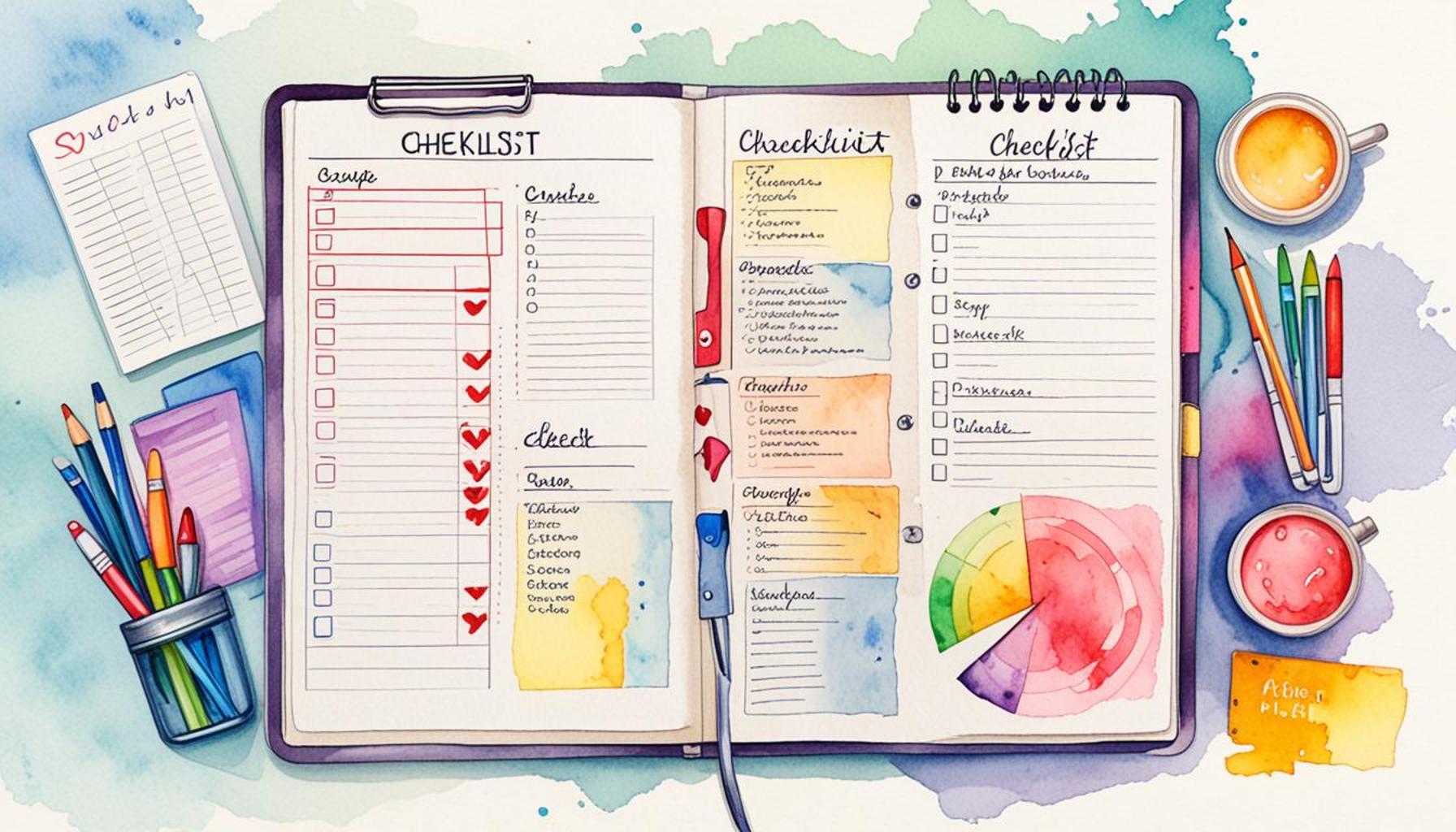Creating Efficient Checklists: The Role of Simplicity in Personal Organization

The Importance of Personal Organization
In today’s fast-paced world, individuals often find themselves juggling multiple responsibilities, from work deadlines to family commitments. In this whirlwind of activity, the art of personal organization has never been more crucial. One of the most effective tools in this endeavor is the checklist—where the act of simply jotting down tasks can lead to remarkable changes in productivity and efficiency.
The Crucial Elements of Effective Checklists
The power of simplicity in checklist design cannot be overstated. An effective checklist is not simply a list of tasks but a carefully constructed guide that simplifies complex ideas and actions. When designing a checklist, consider these essential features:
- Clarity: Use straightforward language to convey tasks. For example, instead of writing “Prepare documents,” specify “Print 5 copies of the quarterly report.” This clarity eliminates any potential confusion.
- Prioritization: Identify the most important tasks to tackle first. A good practice is to categorize tasks into “Must-Dos” and “Nice-to-Dos,” allowing individuals to focus their energies where they are needed most.
- Conciseness: Limit items to avoid overwhelming the user. Ideally, a checklist should contain no more than ten items at a time. This keeps the user focused and prevents feelings of being daunted by long lists.
The Benefits of Checklists
Effective checklists serve numerous purposes that extend beyond mere organization. They can significantly improve efficiency, reduce stress, and foster a sense of accomplishment as tasks are completed. Tailored for various scenarios, checklists can include:
- Daily errands: A grocery list or task checklist can streamline shopping trips. For instance, a well-structured list can help shoppers navigate the store efficiently, saving both time and energy.
- Project management: Checklists can outline essential steps and milestones in bigger projects, such as planning a wedding or launching a business initiative. Each completed task brings teams closer to their project goals.
- Travel planning: Creating a packing checklist ensures that none of the necessary items are forgotten. Items like passports, chargers, and essential clothing can be easily listed and checked off, reducing travel anxiety.
The Impact of Cognitive Load
By focusing on simplicity in checklist design, individuals can create tools that not only guide actions but also enhance clarity and reduce cognitive load. This reduction is vital as it minimizes mental clutter, allowing individuals to think more clearly and make better decisions. Engaging with the checklist process invites the opportunity to unlock higher levels of organization, ultimately leading to a more manageable and fulfilling lifestyle.
In conclusion, mastering the art of checklist creation is a skill worth investing in. It not only transforms task management but also paves the way to greater personal effectiveness and a sense of control in busy lives. Whether for personal errands or professional projects, the checklist remains a timeless instrument in the quest for order and efficiency.

DISCOVER MORE: Click here to dive deeper
Unlocking the Power of Simplicity in Checklists
When it comes to creating efficient checklists, the concept of simplicity plays a pivotal role. By stripping away unnecessary complexity, individuals can craft checklists that are not only effective but also easy to follow. Research shows that cognitive overload can hinder productivity, making it essential to present information in a digestible format. According to a study published in the Journal of Experimental Psychology, simplifying tasks can lead to a 15% increase in task completion rates. Thus, mastering simplicity in checklist creation can yield profound benefits in personal organization.
Key Principles for Simple and Effective Checklists
To enhance productivity and minimize stress, certain principles should guide the creation of checklists. Consider the following key elements:
- Specificity: Be as specific as possible with each task. Instead of vague entries like “clean the house,” detail which rooms need attention or note specific tasks like “vacuum the living room.” The more precise the instructions, the less prone the user is to ambiguity.
- Action-Oriented Language: Use verbs that compel action. Phrases like “Call Sarah about the project” are more motivating than merely stating, “Sarah.” This action-oriented approach inspires individuals to complete tasks promptly.
- Visual Organization: A visual element, such as bullet points or checkboxes, can significantly enhance the usability of a checklist. It allows users to quickly scan the document and identify completed actions, creating a sense of visual satisfaction as they tick off items.
- Contextual Relevance: Tailor checklists to the context in which they will be used. A checklist for grocery shopping will differ from a list for a business meeting. By keeping the specific scenario in mind, individuals can better focus and maximize their productivity.
Simplification in Various Contexts
Simplicity is a fundamental principle that operates effectively across various organizational contexts. Whether preparing for a meeting, organizing a family gathering, or planning a vacation, the application of simple and precise checklists can streamline the process. For instance, when preparing for a meeting, a checklist might include:
- Confirm agenda items
- Gather relevant documents
- Prepare presentation slides
- Set up Zoom link
- Send reminders to attendees
This breakdown not only clarifies the process but also ensures that crucial elements are not overlooked, thereby enhancing overall effectiveness.
As individuals refine their checklist practices, they may discover additional strategies tailored to their unique needs. The incorporation of simplicity not only aids in personal organization but also fosters a culture of efficiency—empowering users to tackle their daily lives with confidence.
Creating Efficient Checklists: The Role of Simplicity in Personal Organization
In the fast-paced world we live in, checklists have become an invaluable tool for personal organization. Their effectiveness lies in their simplicity, allowing individuals to focus on tasks without the overwhelm that comes from complex systems. When utilizing checklists, the key is to distill tasks down into manageable components. This approach not only enhances clarity but also ensures that nothing is overlooked.One powerful strategy for creating effective checklists is to categorize tasks. By grouping similar activities together, users can streamline their focus and increase productivity. For instance, using a categorization such as “Daily Tasks” and “Long-term Goals” provides a clearer overview of both immediate requirements and larger aspirations. This method encourages a check-off mentality and gives a satisfying sense of progress.Another benefit of simple checklists is the ability to adapt them easily. When changes occur in projects or daily routines, adjustments to a straightforward checklist are minimal, allowing for quick reorganization. This flexibility is crucial for maintaining momentum.Additionally, the visual appeal of checklists can enhance usability. Utilizing bold headings, bullet points, or even colorful segments can make checklists more engaging. The aesthetic aspect contributes to motivation, making it easier to tackle tasks. In summary, creation and maintenance of efficient checklists foster personal organization by embracing simplicity. They promote clarity, adaptability, and visual engagement. As a result, users can reap the full benefits of checklists by incorporating these strategies into their daily routines.
| Category 1 | Category 2 |
|---|---|
| Simplicity | Easier focus on tasks without complexity |
| Clarity | Enhanced understanding and task management |
EXPLORE MORE: Click here to uncover the secrets of effective delegation
Embracing Technology for Streamlined Checklist Creation
In today’s digital age, technology has introduced a wealth of tools that can further enhance the effectiveness of checklists while maintaining simplicity. Various applications and software programs have been developed specifically for checklist management, allowing users to create, store, and share checklists effortlessly. Utilizing digital checklists can significantly reduce the time spent on creating repetitive lists and ensure accuracy through autocompletion features.
Popular Digital Tools
With the rise of smart devices, there are numerous applications that have gained traction among users seeking to streamline their organization processes. Some of the most popular tools include:
- Todoist: This app not only allows users to create checklists but also includes project management features, which let users organize tasks by priority and due dates. Its user-friendly interface promotes simplicity, making it accessible for various demographics.
- Google Keep: Known for its straightforward design, Google Keep lets users create color-coded checklists that can be shared with others. The simple layout ensures that focus remains on what needs to be accomplished without unnecessary distractions.
- Asana: While primarily a project management tool, Asana includes checklist capabilities that help teams delegate tasks efficiently. Its integration options allow for the synchronization of lists across various platforms, maintaining the simplicity of organization regardless of where the list is accessed.
These applications embody the principle of simplicity by allowing users to easily access and modify their checklists, providing a seamless experience. Digital checklists also enable users to set reminders and deadlines, which can further amplify their productivity.
Real-World Applications of Efficient Checklists
The power of checklists is evident in a variety of real-life scenarios—from professionals managing work tasks to families coordinating daily chores. In the corporate world, highly effective leaders often resort to checklists to ensure that essential components of a project are addressed. For example, in the aviation industry, pilots utilize checklists to navigate complex pre-flight checks, which are vital for safety. These checklists are meticulously crafted to be straightforward, ensuring every detail is attended to without overwhelming the pilot with excessive information.
In the household domain, parents frequently employ checklists for back-to-school preparations, ensuring nothing is forgotten. Tasks might include:
- Buy school supplies
- Confirm school schedule
- Organize backpacks
- Prepare lunch menus
- Set up school communication apps
These organized lists create an efficient system for families, preventing chaos and ensuring a smoother transition into the school year. The incorporation of simplicity into these everyday checklists eliminates unnecessary stress and enhances clarity.
Ultimately, whether utilized in a professional or personal context, the principles of simplicity applied to checklist creation can lead to a more structured and efficient approach to achieving daily goals. Embracing these practices not only improves individual productivity but also fosters an environment conducive to accountability and focus.
DIVE DEEPER: Click here to discover more
Conclusion: The Power of Simplicity in Checklist Creation
In a world bustling with distractions and responsibilities, creating efficient checklists has become an essential aspect of personal organization. The journey towards improved productivity starts with embracing the principle of simplicity. By crafting checklists that are uncluttered and straightforward, individuals can enhance their ability to focus on tasks while minimizing the risk of overlooking critical details.
Whether employing traditional pen-and-paper methods or leveraging sophisticated digital tools, simplicity remains the cornerstone of effective checklist creation. Each list serves as a beacon of clarity, allowing users to navigate their daily challenges with ease. The integration of technology—through applications like Todoist and Google Keep—further exemplifies the enhanced efficiency that comes from streamlined organization processes.
As highlighted through various real-world applications, from the aviation industry to everyday family errands, the impact of well-structured checklists is profound. They not only contribute to smooth operations but also cultivate an atmosphere of accountability and proactive management. The time invested in creating these simple tools pays dividends in both personal and professional realms, fostering greater satisfaction and success.
To reap the full benefits of checklist usage, one must recognize that simplicity is not merely a preference but a necessity in personal organization. By continuously refining our approach to checklist creation, we not only simplify our lives but also inspire a more productive future. Therefore, it is time to embrace checklists as indispensable allies in achieving our goals, inviting us to discover the transformative effects of simplicity on our journey towards effective personal organization.


